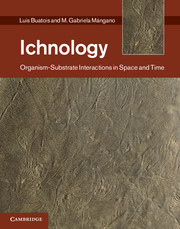Book contents
- Frontmatter
- Contents
- Acknowledgments
- Introduction
- Part I Conceptual tools and methods
- Part II Spatial trends
- Part III A matter of time
- 12 Trace fossils in sequence stratigraphy
- 13 Trace fossils in biostratigraphy
- 14 Trace fossils in evolutionary paleoecology
- 15 Ichnology in paleoanthropology and archaeology
- References
- Index
12 - Trace fossils in sequence stratigraphy
from Part III - A matter of time
Published online by Cambridge University Press: 25 October 2011
- Frontmatter
- Contents
- Acknowledgments
- Introduction
- Part I Conceptual tools and methods
- Part II Spatial trends
- Part III A matter of time
- 12 Trace fossils in sequence stratigraphy
- 13 Trace fossils in biostratigraphy
- 14 Trace fossils in evolutionary paleoecology
- 15 Ichnology in paleoanthropology and archaeology
- References
- Index
Summary
For my part, following out Lyell’s metaphor, I look at the natural geological record, as a history of a world imperfectly kept, and written in a changing dialect; of this history we possess the last volume alone, relating only to two or three countries. Of this volume, only here and there a short chapter has been preserved; and of each page, only here and there a few lines.
Charles Darwin On the Origin of Species (1859)Trace fossils are proving to be one of the most important groups of fossils in delineating stratigraphically important boundaries related to sequence stratigraphy.
George Pemberton and James MacEachern “The sequence stratigraphic significance of trace fossils: examples from the Cretaceous Foreland Basin of Alberta, Canada” (1995)The appearance of sequence stratigraphy in the late eighties resulted in a revolution in the study of sedimentary rocks. The shift from seismic stratigraphy (Vail et al., 1977) to sequence stratigraphy brought the incorporation of outcrops and cores as sources of data in stratigraphic analysis (Posamentier et al., 1988; Posamentier and Vail, 1988; Van Wagoner et al., 1990). Coincident with this shift, ichnological studies began to emphasize the importance of trace fossils in sequence stratigraphy (e.g. Savrda, 1991b; MacEachern et al., 1992; Pemberton et al., 1992b). In little more than a decade, the field experienced a rapid increase in the number of studies devoted to exploring the applicability of ichnology in refining sequence-stratigraphic analysis (e.g. MacEachern et al., 1992, 1999a, 2007c; Savrda et al., 1993; Taylor and Gawthorpe, 1993; Pemberton and MacEachern, 1995; Ghibaudo et al., 1996; Martin and Pollard, 1996; Buatois et al., 1998d, 2002b; Pemberton et al., 2001, 2004; Carmona et al., 2006). At present, ichnological aspects are currently covered in sequence-stratigraphic textbooks (e.g. Catuneanu, 2006). The aim of this chapter is to provide a detailed review of the applications of ichnology in sequence stratigraphy. Although a large part of this chapter deals with the recognition of discontinuity surfaces in marine siliciclastic successions, we will also cover other topics which are commonly overlooked in the literature. These include characterization of parasequences, parasequence sets, and systems tracts, but also the potential of trace fossils to address sequence-stratigraphic issues in carbonates and continental deposits.
- Type
- Chapter
- Information
- IchnologyOrganism-Substrate Interactions in Space and Time, pp. 231 - 251Publisher: Cambridge University PressPrint publication year: 2011

